Great American Rail-Trail Route Assessment Report 2023
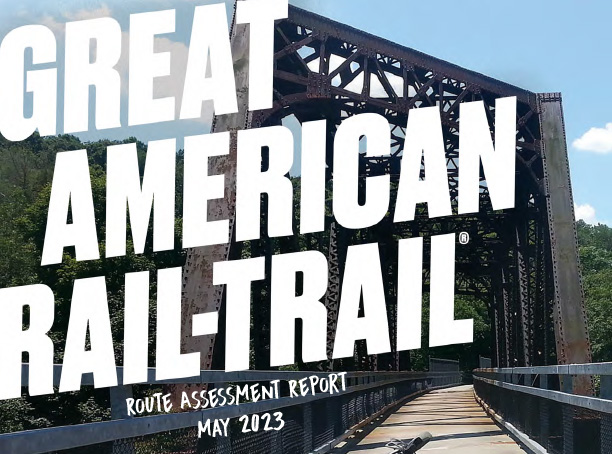
EXECUTIVE SUMMARY
To this end, RTC embarked on a 12-month assessment of route options using its GIS database of more than 34,000 miles of existing, multiuse trails nationwide, and analyzing more than 300 state and local trail plans to identify planned future trails. RTC also met and worked with more than 200 local trail partners and more than 50 state agencies representing the trails along the route, shaping criteria to ensure safe, non-motorized travel on a route that is entirely walkable and bikeable. These trail criteria specify that the Great American Rail-Trail be one contiguous route that is preliminarily more than 80%, and ultimately entirely, off-road and separated from vehicle traffic; comprise existing trails to the extent possible; be reasonably direct from Washington to Washington; be amenable to the state and local jurisdictions through which it will cross; and serve as a catalyst for local economic development, including providing services for long-distance travelers.
Through the assessment, RTC and its partners have defined the preferred route of the Great American Rail-Trail as more than 3,700 miles—with approximately 2,057 miles of existing trails (trails along the route that are built and maintained by dedicated teams of local staff and volunteers) and 1,696 miles of identified trail gaps (sections of trail that still need to be developed).
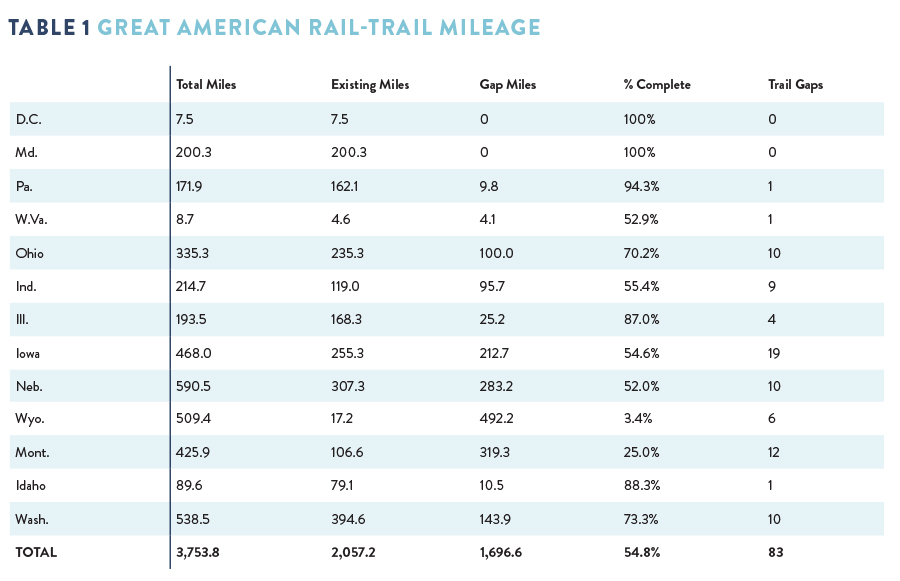
While there are more than 1,600 miles of trails to complete along the route of the Great American Rail-Trail, each trail gap has one or more future trail options identified as possible trail connections. Many of these gaps and proposed future trails are already identified in public plans that have been adopted at the state and local levels. Insight from local trail partners and states has helped to identify the preferred alignment that best corresponds with their priorities, with the intention of maximizing existing trail momentum as the Great American Rail-Trail is connected across the country.
STATE-BY-STATE SNAPSHOT
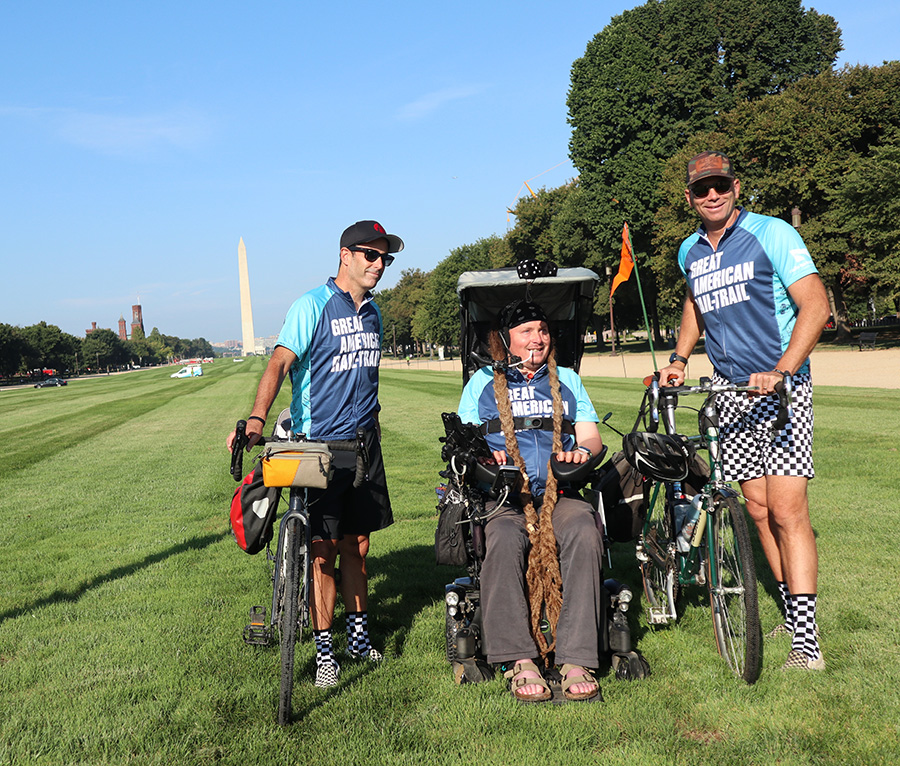
WASHINGTON, D.C., AND MARYLAND
The trail route through Washington, D.C., and Maryland is the only section of the Great American Rail-Trail that is currently 100% complete. The route begins at the steps of the U.S. Capitol and picks up at the Capital Crescent Trail in Georgetown, which flows into the towpath of the Chesapeake and Ohio (C&O) Canal National Historical Park. With the C&O stretching from Washington, D.C., to Cumberland, Maryland, the route then meets up with the Great Allegheny Passage (gaptrail.org).
PENNSYLVANIA
The route through Pennsylvania connects several existing trails and includes a gap of fewer than 10 miles between Pittsburgh and Coraopolis. By connecting the trail through Pittsburgh, the Great American Rail-Trail also connects to the Industrial Heartland Trails Coalition (IHTC), a 1,500-mile network of trails that is part of RTC’s TrailNationTM portfolio. The IHTC network will stretch across 51 counties in four states—Pennsylvania, West Virginia, Ohio and New York—from the shores of Lake Erie to the confluence of the three rivers in Pittsburgh and on to the Ohio River and Appalachian foothills.
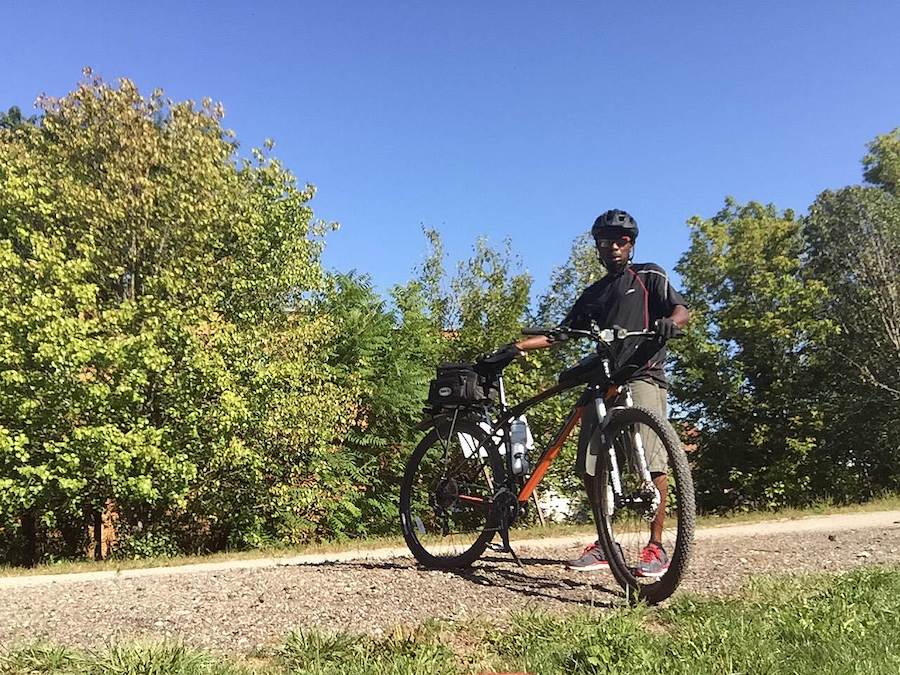
WEST VIRGINIA
Traveling through the Northern Panhandle and along the Ohio River, the Great American Rail-Trail’s path through West Virginia contains the least number of miles of any state across the route. As such, West Virginia has the smallest portion of trail to develop, with a 4.1-mile trail gap from the end of the Panhandle Trail in Weirton to the Market Street Bridge to cross the Ohio River into Steubenville, Ohio. Like Pennsylvania, the route through West Virginia is also along the Cleveland to Pittsburgh corridor of the proposed 1,500-mile IHTC trail network.
OHIO
Several iconic trails make up the route across Ohio, which is already more than two-thirds complete. The Ohio & Erie Canalway Towpath Trail connects New Philadelphia to Cleveland, providing a rich history and unique experience along the way. Instead of following the Ohio & Erie Canalway Towpath Trail all the way north to Cleveland, however, the Great American Rail-Trail will branch off at Clinton and head southwest on the Ohio to Erie Trail, which travels to Cincinnati through Columbus.
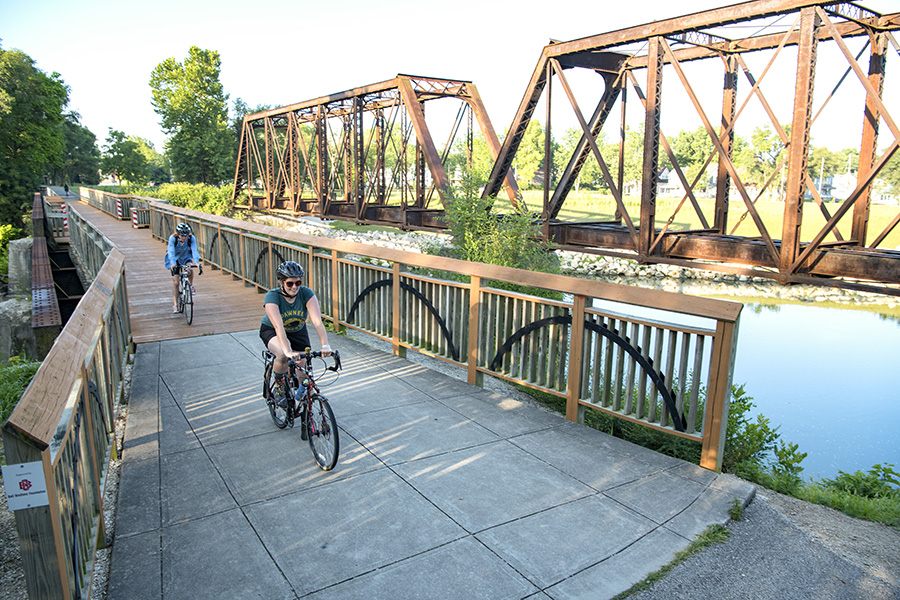
INDIANA
RTC met with Indiana state officials early in the Great American Rail-Trail process, recognizing that the route through Indiana would have a significant impact on the potential routes through its neighboring states. After analysis, two routes were presented: a shorter one across the north of the state and a longer diagonal one from Richmond, Indiana, toward the Chicago metropolitan area. State officials were excited about the potential of the Great American and asked RTC to consider including as many miles as possible in Indiana by using the longer diagonal route. To complete the preferred route through Indiana, about 95 miles of trail gaps will need to be addressed. With the state’s commitment to its Next Level Connections program—a $1 billion investment in infrastructure projects, including at least $150 million for trails—there is great optimism for the necessary development to be completed.
ILLINOIS
The route through Illinois incorporates the majority of the northern leg of the Great Illinois Trail between Lansing, Illinois, and the Quad Cities. The iconic Illinois & Michigan Canal State Trail and Hennepin Canal Parkway make up almost 75% of the existing miles that the Great American Rail-Trail will use to cross the state. Strategic investments will be required to develop just over 25 miles of trail gaps and fully connect the Great American across Illinois.
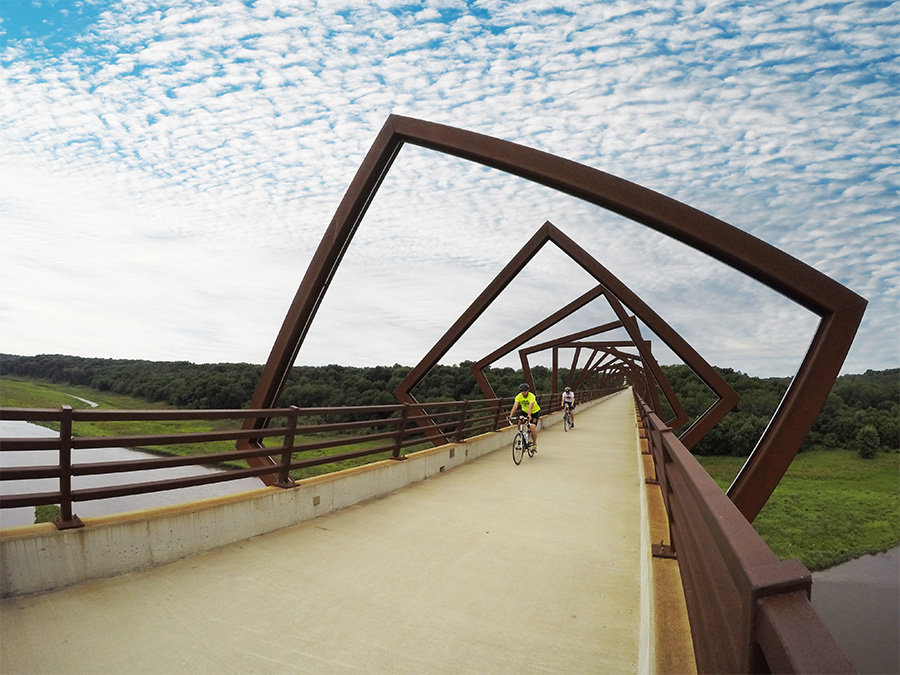
IOWA
The Great American Rail-Trail travels through Iowa from Davenport to Council Bluffs at the western end of the state. Iowa has a rich network of trails, and on-the-ground trail partners are critical to its thriving trail culture and the development of the Great American in the state. While there are currently more than 212 miles of trail gaps to develop, support for the Great American was mentioned in the 2018 Iowa Bicycle and Pedestrian Plan, showing statewide support for the completion of the route through Iowa.
NEBRASKA
The Great American Rail-Trail crosses into Nebraska on the iconic Bob Kerrey Pedestrian Bridge before weaving through the urban areas of Omaha and Lincoln. The Cowboy Recreation and Nature Trail (the “Cowboy Trail”) takes trail users almost 40% of the way across Nebraska, with more miles set for construction in the near future. With over 283 miles of trail gaps to develop along the preferred route through Nebraska, completing the Cowboy Trail will go a long way toward making the Great American a reality.
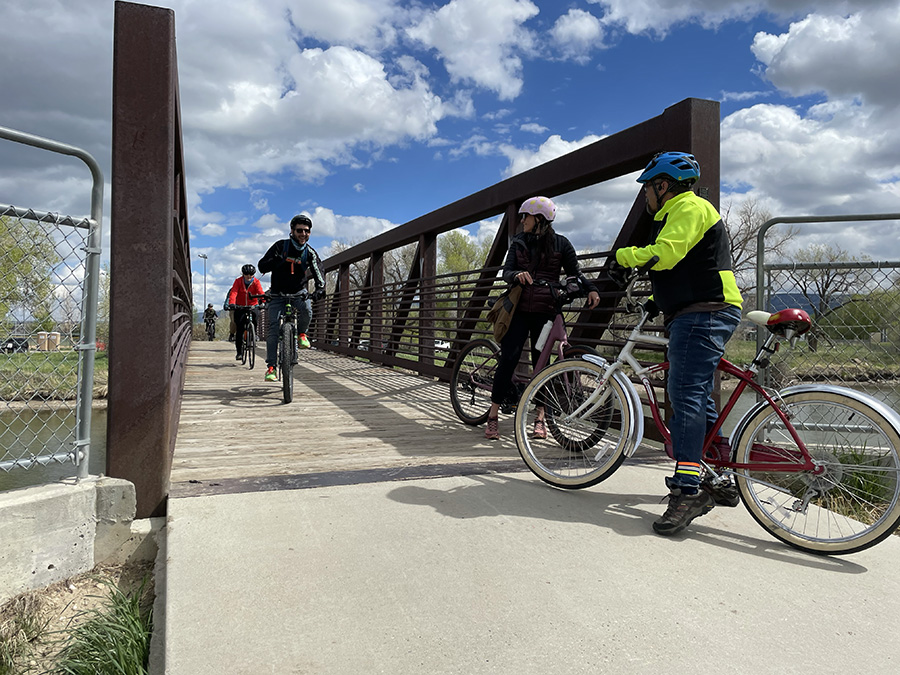
WYOMING
Wyoming has the potential to be an incredible section of the Great American Rail-Trail, with its unique landscapes and outdoor recreation assets. However, because of Wyoming’s topography, any route through the state will require sizable grade increases at several locations, and currently, there are not significant miles of multiuse trail available to route a trail across the state. As a result, Wyoming has more trail gaps to develop—at just over 492 miles—than any other state along the Great American route. RTC reviewed mapping data, as well as various plans in Wyoming, identifying potential routes through Yellowstone National Park that could present opportunities for the Great American. In addition, the Wyoming Bicycle and Pedestrian System Task Force Report suggests that the Wyoming Legislature consider providing funding for the Great American as part of a recommended initiative to enhance the safety and function of long-distance bicycle tourism routes.
MONTANA
The Great American Rail-Trail route through Montana will connect many of the state’s communities known for outdoor recreation assets—including Livingston, Bozeman, Three Forks, Butte and Missoula—which are all along the preferred Great American route. There are currently 319 miles of trail gaps to be developed in Montana, including an off-road 50-miles-plus multiuse trail option connecting Gardiner to Livingston in Park County.
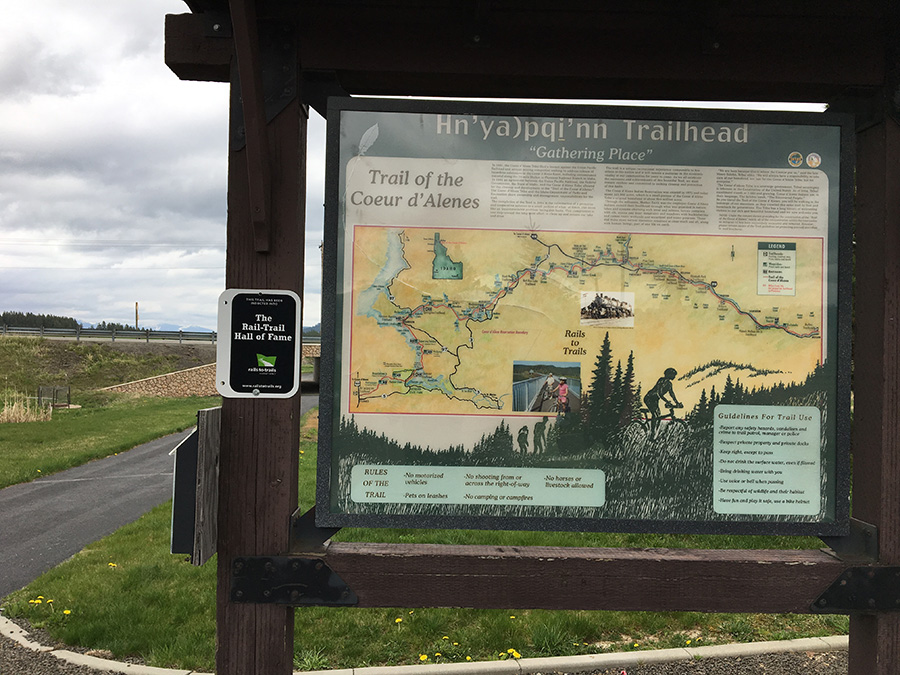
IDAHO
The Great American Rail-Trail travels through the northern Panhandle of Idaho, primarily along developed rail-trails. Idaho has just one trail gap to complete, a connection from the city of Plummer to the Idaho–Washington state line. The state of Idaho and local officials will need to continue to work with landowners through the Lovell Valley to find an opportunity to complete the 10.5-mile connection between the Trail of the Coeur d’Alenes and the Palouse to Cascades State Park Trail.
WASHINGTON
The Washington section of the Great American Rail-Trail begins with the Palouse to Cascades State Park Trail, which travels approximately 250 miles, from the Idaho–Washington state line to the community of Cedar Falls. The largest gap in the Palouse to Cascades State Park Trail is 37.8 miles between the city of Warden and the unincorporated community of Smyrna, ultimately traveling to the city of Othello. Creative solutions that include the rail line and highway rights-of-way between Warden and Othello should be considered to help fully close this large gap in the trail. The Great American Rail-Trail will continue west through King County and Seattle, crossing Puget Sound via ferry to Bainbridge Island. The burgeoning Sound to Olympics Trail and Olympic Discovery Trail will complete a trip to the Pacific Ocean at the town of La Push on the Quileute Reservation.
THE PATH TO THE GREAT AMERICAN RAIL-TRAIL
The Great American Rail-Trail marks an unprecedented commitment by RTC and its public and private partners to create an iconic piece of American infrastructure that will connect more than 3,700 miles of rail-trail and other multiuse trails from Washington, D.C., to Washington State. This ambitious project will provide ample benefits to the communities, people and places it touches, while creating new connections to the American landscape for all who use the trail. While the work to complete the Great American Rail-Trail is significant, RTC and its partners along the route have created a blueprint for the trail’s development; the route assessment provides important guidance to local planners, trail managers, state agencies and national partners that is based in the reality of existing plans and priorities. And while the ultimate completion of the Great American Rail-Trail is likely decades away, the 54% complete today is ready for the world to enjoy, and the momentum behind it will bring new segments onboard year after year.
ACKNOWLEDGMENTS
This report, Great American Rail-Trail Route Assessment, was originally published by Rails-to-Trails Conservancy (RTC) in May 2019. This updated version was published in May 2023.*
Suggested citation: Rails-to-Trails Conservancy. Great American Rail-Trail Route Assessment. Washington, DC: Rails-to-Trails Conservancy, 2023.
RTC staff and consultants who provided expertise and skills necessary to the production of this report include: Amy Ahn, Kevin Belle, Ken Bryan, Sharon Congdon, Leah Gerber, Andrea Holliday, Brandi Horton, Annie Hunt, Amy Kapp, Joe LaCroix, Kevin Mills, Yvonne Mwangi, Eric Oberg, Kelly Pack, Aishwarya Shrestha, Laura Stark, Derek Strout, Liz Thorstensen and Marianne Wesley Fowler.
ABOUT RAILS-TO-TRAILS CONSERVANCY
RTC is the nation’s largest trails organization—with a grassroots community more than 1 million strong—dedicated to connecting people and communities by creating a nationwide network of public trails, many from former rail lines. RTC serves as the national voice for the nation’s 40,000+ miles of rail-trails and multiuse trails, and 8,000+ miles of potential rail-trails ready to be built, with the goal of creating more walkable, bikeable communities in America. Connect with RTC at railstotrails.org and @railstotrails on Facebook, Twitter and Instagram.
View the trails along the route at traillink.com/great-american-rail-trail and learn more about the Great American Rail-Trail at greatamericanrailtrail.org and RTC’s network-building initiative at trailnation.org. Follow the Great American Rail-Trail at @greatamericanrailtrail on Facebook and Instagram.
* Trail developments have been provided as of April 2023.

Donate
Everyone deserves access to safe ways to walk, bike, and be active outdoors.